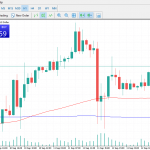Table of content
Technical indicators are widely used by prop traders to pass challenges and start making profits. Trading challenges have become popular lately, and there is a good reason for it. Traders can access substantial trading capital and make huge profits on funded accounts. This unique offering of proprietary trading firms allows traders to trade in financial markets almost risk-free. Let’s briefly explain what prop challenges are and how to pass them using the most suitable technical indicators.
Trading indicators for passing the challenges
Technical indicators are mathematical formulas that take in price data for a particular asset and display some analysis. For example, the Zig Zag indicator is perfect for detecting trend lines and capitalizing on breakouts or trends. However, without a zig zag indicator user guide, it might become tricky to use these indicators. The same is true for other technical indicators that show different things. Using Zig Zag, traders can detect trends, similarly to moving averages. Other indicators like ADX and RSI are best to measure the strength of price swings and trends, allowing traders to anticipate changes in price direction. Different indicators are useful in different scenarios, and passing challenges become easier when proper indicators are employed.
What are trading challenges?
Proprietary trading challenges are specialized challenges where traders show tier trading performance under strict risk parameters and gain access to trading accounts with substantial capital. Trading challenges are the best way for traders who have viable strategies to gain access to large trading accounts.
Prop challenges versus trading competitions: what’s the difference?
Prop challenges differ from trading competitions. In the latter, only several traders get rewards for winning the competition. In the prop trading challenge, anyone who reaches a predefined profit target without breaching rules gets access to funded accounts.
Key criteria of prop trading challenges
Prop firms have numerous rules to protect their capital from irresponsible trading. These rules include daily risk limit, maximum drawdown, and allowed trading strategies. The most popular daily risk limit varies between 3 to 5%, and the maximum drawdown is typically set around 8%. Traders must not lose more than a predefined percentage on any single trading day to avoid disqualification.
Top trading indicators for prop challenges
There are hundreds of popular technical indicators used by traders in prop trading. However, the following ones are most suitable for passing the challenges.
Moving Averages (MA)
Moving averages are probably one of the oldest and most popular indicators out there. They are used in every asset including Forex, stocks, futures, etc. Moving averages smooth out price data to identify trends. There are several types of moving averages. Most popular of them include:
- Simple Moving Average (SMA) — SMA is an average of a set number of past closing prices. Users can specify the period. SMA can be used for detecting trend direction and support/resistance levels.
- Exponential Moving Average (EMA) — EMA is similar to SMA but gives more weight to recent prices. EMAs are more responsive to recent price changes, making them suitable for more short-term trading signals.
Relative Strength Index (RSI)
RSI measures the speed of change of price movements, oscillating between 0 and 100. RSI is often used for identifying oversold and overbought conditions in the price action.
- Overbought — When RSI is 70 and above, it indicates a market might be overbought, and it is time to anticipate reversal.
- Oversold — When the RSI falls below 30, it might indicate oversold conditions and the price might reverse soon.
Moving Average Convergence Divergence (MACD)
MACD is also among the most popular technical indicators used by both beginners and seasoned traders. MACD is great for revealing momentum as it compares two moving averages. MACD consists of a MACD line, a Signal line, and a Histogram. Traders can identify bullish or bearish momentum by looking at the behavior of MACD. The indicator gives a crossover signal when the MACD line crosses the Signal line, and many traders use this event for trading signals.
Bollinger Bands
Bollinger bands are another popular indicator, mainly for trend trading. BB consists of a moving average and upper and lower bands. BB is a powerful indicator for measuring the volatility in price. When bands widen, the volatility is high, and they contract during low volatility. Bollinger Bands can be used as dynamic trend lines.
Fibonacci Retracement Levels
Fibonacci retracement is a popular tool that uses horizontal lines to indicate areas of support and resistance. Key Fibonacci levels include 23.6%, 38.2%, 50%, 61.8%, and 78.6%. The tools are especially powerful for identifying potential reversal levels, and many pro traders use them for this purpose.
Overall, not any single technical indicator can be used as a stand-alone signal provider, and it is always suggested to combine several of these indicators for more accurate decisions.

